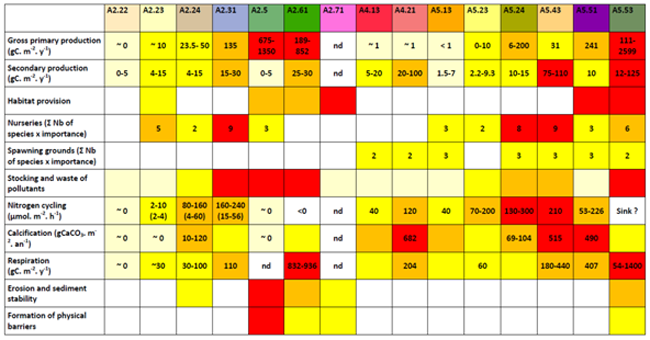5.4.5.1 Golfe Normand-Breton: Linking Habitats, Functions and Services

In most cases, Marine Ecosystem Services Assessment is required in the context of a marine policy which may target the protection of marine habitats and biodiversity. Such policies are better informed by assessments which highlight the most important habitats or the key ecological functions for delivering ecosystem services.
However, even if it is often referred to in the “cascade approach”, the relationships between habitat, functions and services within marine ecosystems are not well known and understood.
A step forward in that direction was attempted in the Golfe Normand-Breton study site, which proposed a first overview of the services delivered by the diverse habitats of this site in the prospect of the creation of new Marine Protected Area.
Being part of an initial diagnosis, this exercise tried to identify and assess the contribution of all the habitats to key ecological functions and services.
The identification phase raised the issue of the appropriate scale, considering habitat heterogeneity and knowledge gaps.
 It appeared feasible to recreate a complete map of the diverse habitats of the site using EUNIS classification level 4; however, this map was based on a set of oceanographic data collected over more than 40 years, what indicates that the current status of some habitats may remain doubtful.
It appeared feasible to recreate a complete map of the diverse habitats of the site using EUNIS classification level 4; however, this map was based on a set of oceanographic data collected over more than 40 years, what indicates that the current status of some habitats may remain doubtful.
The second step of this work consisted in linking those habitats with functions and services based on the available knowledge. The ecological functions were assessed using a large variety of sources.
Peer-reviewed papers were used first, some of them concerning a smaller part of the Golfe Normand-Breton (Mont-Saint-Michel Bay), comparable close areas (Bay of Morlaix) or more distant areas (Bay of Arcachon). Other sources included unpublished in-situ observations or simple expert judgment.
 Table: Main ecological functions delivered by the various habitats of the Normand-Breton Gulf
Table: Main ecological functions delivered by the various habitats of the Normand-Breton Gulf
This variety and heterogeneity of sources led the ecologists from the study site team to propose a confidence interval for the assessment of ecological functions based on three criteria:
- the quality of information sources, considering the nature of the source (peer-reviewed papers, reports, expert judgement) and the nature of the data (field observations, modeling results)
- the applicability of evidence, according to the nature of the habitat and the location (increasing distance from Gulf Normand-Breton to English Channel and North-East Atlantic)
- the degree of concordance, which depend on the number of observations and the range of values.
The ecological assessment of the GNB highlighted the importance of four categories of habitats:
- coastal saltmarshes and saline reedbeds (Eunis A2.5)
- littoral and sub-littoral seagrass beds (Eunis A2.61 and A5.53)
- heterogeneous sediments in the infralittoral zone (Eunis A5.24, A5.43)
- maerl beds (Eunis A5.51)
The main functions which these habitats deliver are gross primary production, secondary production, habitat provision, nurseries, stocking and waste of pollutants, nitrogen cycling, calcification and respiration.
Based on expert judgment only, the link between habitats and services was also assessed, which revealed the major role:
- of intertidal habitats for shellfish farming
- of coarse sand and gravel habitats for commercial fishing
- of saltmarsh for traditional activities, of intertidal habitats for recreative activities but also for other cultural services
- of some offshore habitats in contributing to the cultural heritage in relation with fishing activities
- of offshore habitats in the provision of nurseries and the ocean nourishment.
The analysis suggested also the possible contribution of nearshore habitats to the regulation of water quality and coastal protection and the possible negative effects of some habitats on some services (e.g. act as a source of CO2).
This attempt to fill the knowledge gaps concerning the habitats-functions-services relationships in marine ecosystems produced the following insights:
- Carrying out such an analysis based on literature review and exchanges with experts is time-consuming, but it generates no additional costs from field observations and experimentations. However, available knowledge may not be sufficient to assess the current status of all the habitats.
- Large gaps in functional ecology prevent from properly assessing the role of the main habitats in regulation services: this is due to lack of basic data, the limitations of data collected for other purposes and also heterogeneity in ecological functions.
- As it remains difficult to assess all the relationships between habitats and functions or services, it is clearly needed to focus on some major functions and services according to the management issues.
- Finally, the analysis of the habitats-functions-services relationships, although complicated, may help to move further from a static vision toward a dynamic system, taking into account the changes in the services delivery in response to human pressures.
- More work is also need to better understand the cumulative effects of pressure on ecological functions and ecosystem services.

